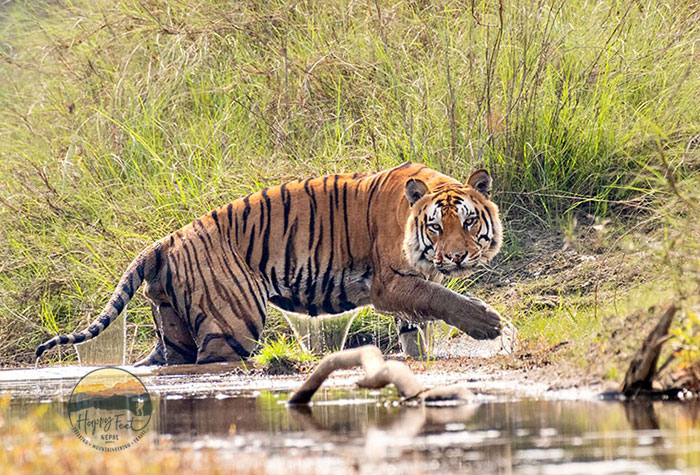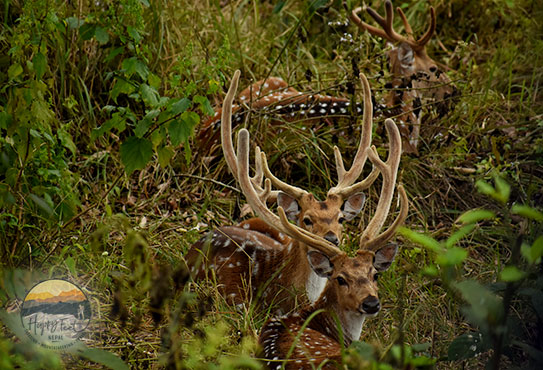-
Sunday - Friday: 9 AM - 4 PM
Chitwan National Park Safari
2 nights 3 days package tour
Chitwan National Park is one of the most famous and oldest National Park, listed as Asia’s best National Park for wildlife, located in the subtropical lowlands Terai belts of South-Central Nepal; been listed as a World Heritage site since 1984.
This National Park covers a pristine area with a unique ecosystem of significant value to the World. The Chitwan National Park contains Churia hills, ox-bow lakes, and Rapti and Narayani river flood plains.
The Chitwan National Park has 43 species of wildlife, including the elusive Royal Bengal Tiger, one-horned Rhinoceros, freshwater Gharial crocodiles, gaur (Asian bison), wild elephants, four-horned antelopes, Gangetic dolphins, striped hyenas, monitor lizards, pangolins, and python. Other wildlife in the park is Sambars, barking deer, chital (spotted deer), sloth bear, palm civets, languor and rhesus monkeys.
Chitwan is also home to more than 450 species of birdlife, including the Giant Hornbill, Bengal Florican, Lesser Florican, Black Stork and White Stork. Other common birds seen in the park include Peafowl, Red Jungle fowl, Herons, Kingfishers, Woodpeckers, Egrets, and Flycatchers.
Chitwan National Park is also known for 45 species of amphibians and reptiles, including Marsh mugger Crocodile, Green Pit Viper, cobras, and various species of frogs and tortoises.
Chitwan National Park has many lodges, jungle resorts and tented safari camps. The park can be reached via the overland journey of 190 kilometres from Kathmandu or Pokhara by a 20-minute flight to Megauli or Bharatpur, including a short ride on a four-wheel drive. The ultimate way may also reach it with a surge of adrenaline and scenic floats Rafting on the Trisuli River. March to December months are the best time to watch the birdlife here.
After an early breakfast, we depart for Chitwan. The trip will last approximately 5 hours. Upon arrival, a welcome drink gets served, followed by lunch. In the afternoon, the nature guide will take you on Elephant Back Safari: Guests will ride on an elephant to explore the wildlife, including the one-horned rhinoceros, several types of deer, monkeys, wild boars, bison, sloth bear, leopard and if lucky, the Royal Bengal Tiger. This exciting ride lasts for 2-3 hours.
7:00 p.m.: Slide Presentation: One of our jungle experts will introduce background data, the history of the Royal Chitwan National Park, and some other topics relating to wildlife. OR. Tharu Stick Dance: farmers of the nearby village will show some of their traditional skills and dances, followed by a dinner at around 8:00 p.m.
Receive a wake-up call followed by tea/coffee and cookies. The day’s activity starts with a short nature walk. Breakfast gets served at around 8:30 a.m. Then the nature guide will take you to the Elephant briefing program: learn more about these fascinating animals while visiting the elephant stable. Then return to the resort for a hearty lunch.
After lunch, the nature guide will take you on a Jeep Safari/canoe trip. Drive to Kasara, the headquarter of The Royal Chitwan National Park, to see the Gharial (Alligator) hatchery project, founded by the Frankfurt Zoological Society. After a short briefing about the project, drive to the Oxbow lakes (Laxmi Tal and Tamar Tal) by Land Rover through dense sal forest to encounter various plants and other wildlife. And a brief walk to the canoeing put in point. Start canoeing in a traditional dug-out canoe which takes you on a silent trip down the Rapti River to view aquatic birds, crocodiles and the animals of the river bank.
Receive a wake-up call followed by tea/coffee and cookies. Then the guide will take you bird watching in the jungle, home to hundreds of local and migratory birds. Breakfast gets served around 8:00 a.m. After breakfast, we leave the resort and head for Kathmandu, 200 kilometres and 5 hours away. First, we drive along the East-West Highway up to Hetauda, an industrial town, where we stop for snacks. From Hetauda, the entire road is winding, and the views are spectacular until we reach Shim Byanjyang.
Shim Byanjyang, situated at 2,300m, is where one can see the most extended portion of the Himalayas: Dhaulagiri in the west to Mount Everest in the east. We arrive in Shim Byanjyang for lunch. After lunch, the road continuously descends to Naubise, passing through several charming towns, including Tistung and Palung villages.
The 85 kilometres get covered in about 3 hours. Finally, we reach Naubise, join the main highway and enter Kathmandu. Arrive in Kathmandu, check-in formalities, and rest.


